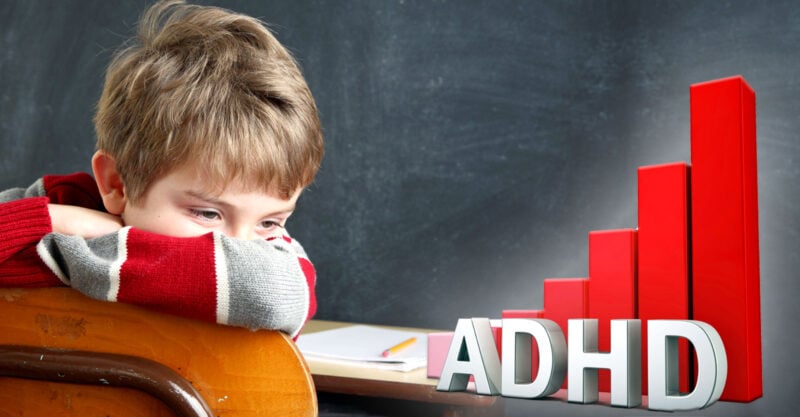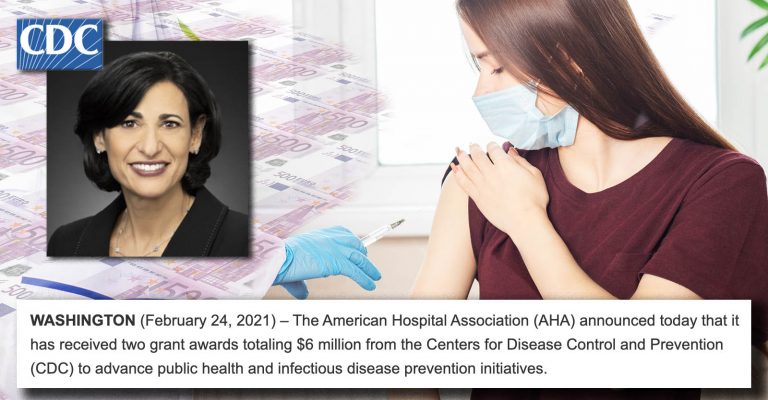1 in 9 Kids Diagnosed With ADHD, CDC Says — But Why?
A new CDC study found that 11.4% of U.S. children aged 3-17 years have at some point been diagnosed with ADHD — up from 9.9% in 2016. Experts criticized the widespread normalization of trends and the unwillingness of researchers to make a connection to chemical exposures and harmful ingredients in childhood vaccines.
Published in The Defender May 30, 2024 by John-Michael Dumais
One in nine U.S. children have been diagnosed with attention-deficit/hyperactivity disorder (ADHD) — an increase of approximately 1 million since 2016 — according to a new study by the Centers for Disease Control and Prevention (CDC).
The study, published this month in the Journal of Clinical Child & Adolescent Psychology, showed 11.4% of children ages 3-17 years (7.1 million) as having at some point been diagnosed with the condition, and 10.5% (6.5 million) currently living with ADHD.
In 2016, 9.9% of children at some point in their lives had been diagnosed with ADHD and only 8.9% of children were living with the condition.
Led by Melissa L. Danielson, MSPH of the CDC’s National Center on Birth Defects and Developmental Disabilities, the study used data from the 2022 National Survey of Children’s Health (NSCH) to calculate its estimates.
The researchers analyzed data from 45,169 children ages 3-17, focusing on “ever diagnosed” and “current ADHD” prevalence. They also examined differences in prevalence across various demographic subgroups, including age, sex, race, ethnicity, household income and insurance status.
The authors spotlighted the high prevalence of moderate-to-severe ADHD, co-occurring mental health disorders and suboptimal treatment rates.
The study comes as Sweden recently reported an explosion of ADHD cases in 2022, with 10.5% of boys and 6% of girls diagnosed with the condition.
Study doesn’t connect ADHD to vaccines, toxic chemicals
Responding to the study findings, Dr. Paul Thomas, author of “The Vaccine-Friendly Plan” and co-founder of KidsFirst4Ever, told The Defender that his vaxxed-unvaxxed study showed “zero ADHD in the unvaccinated compared to significant ADHD in the variably vaccinated.”

While scientists and public health officials often cite genetic predisposition as a causal factor in ADHD, Thomas said genetic vulnerability relates more to an increased susceptibility to toxins like the weedkiller glyphosate and aluminum in vaccines.
“What some might call genetic is just a toxic effect of exposures in the womb,” he said, citing the MTHFR single nucleotide polymorphism that “can make it more difficult to get toxins out of the body.”
Paul said MTHFR also affects one’s ability to produce enough dopamine and norepinephrine, the neurotransmitters thought to be involved in mental focus — an issue at the heart of ADHD.
“Vaccines are by far the greatest source of aluminum toxicity,” he said. “The large doses of aluminum bypass the gut epithelial lining that can remove 99.9% of [normally] ingested aluminum.”
Brian Hooker, Ph.D., chief scientific officer for Children’s Health Defense and co-author of “Vax-Unvax: Let the Science Speak,” cited a study he conducted with Neil Miller in 2021 that found fully vaccinated children were 20.8 times more likely to be diagnosed with ADD/ADHD compared with their unvaccinated counterparts.
The study used a survey-based instrument but all cases of ADD/ADHD were verified using medical chart abstraction, Hooker said.
Hooker told The Defender:
“It is difficult to narrow down a single mechanism for the connection between ADHD and vaccine components — although mercury and aluminum are both neurotoxins.
“But the neuroinflammation that occurs especially from early childhood vaccines does create a condition where brain immune cells [astrocytes and microglia] are in a constant state of immune activation, causing damage to neurons.”
Wave of new studies link ADHD to toxic exposures
In a paper published May 24 in the journal Surgical Neurology International, Dr. Russell Blaylock, a retired neurosurgeon, expanded on Hooker’s thesis.
He showed that aluminum exposure from foods, chemical exposures, pharmaceuticals and vaccines induced immunoexcitoxicity in the brain and spinal cord, resulting in neurodevelopmental and neurodegenerative disorders.
“This mechanism involves activation of the brain’s innate immune system, primarily the microglia, astrocytes, and macrophages, with a release of neurotoxic concentrations of excitotoxins and proinflammatory cytokines, chemokines, and immune mediators,” Blaylock wrote.
A study published In March in the Journal of Xenobiotics found that parental exposure to toxic chemicals resulted in an increased risk of ADHD and autism in their children.
A study published in January in Frontiers in Public Health found that prenatal and early childhood exposure to pyrethroid insecticides were associated with increased risks of ADHD, autism and endocrine disruption.
In April, The U.S. Environmental Protection Agency proposed a ban on the pesticide acephate in food production due to its adverse health effects in children, including ADHD and autism.
Despite this growing body of evidence, the CDC study neglected to draw any connection between the increased prevalence of ADHD and vaccination or toxic chemical exposure.
Prevalence of ADHD diagnoses
The prevalence of ADHD diagnoses in the CDC study varied by age group, with 2.4% of children ages 3-5 years, 11.5% of children ages 6-11 years and 15.5% of adolescents ages 12-17 years having ever been diagnosed.
Boys were more likely to have an ADHD diagnosis than girls, with a prevalence ratio of 1.8:1 in 2022, a slight decrease from the ratio of over 2:1 reported in previous studies.
The study found higher estimates of ADHD diagnoses among non-Hispanic White and non-Hispanic Black children compared to non-Hispanic Asian and Hispanic children.
ADHD diagnoses were more common for children living in lower-income households, children with public health insurance and children living in rural areas.
The authors identified several factors that may have contributed to the observed increase in ADHD prevalence, including heightened awareness of the disorder among parents, teachers and healthcare professionals.
The authors also suggested that COVID-19 pandemic-related stressors, such as changes in school routines and increased social isolation, may have exacerbated ADHD symptoms in some children, leading to more diagnoses.
In January, a JAMA Psychiatry investigation reported that prescriptions for ADHD drugs increased 14% in the first two years of the COVID-19 pandemic, most notably for young adults and women, leading to drug shortages.
Children’s health writer Anne Dachel, responding to the study’s findings and the authors’ theories about causation — which the media widely repeated — wrote on her Substack about the increasing normalization of such conditions.
“We’re so used to people with ADHD that hearing about more kids with a diagnosis doesn’t matter. … Just like autism, it’s only going to get worse. … Why wouldn’t it just keep growing? What’s going to stop it? … Regardless, it’s not a big deal. There are medications for this, even if they haven’t been really tested for their side effects.”
About 1 in 7 kids with ADHD also diagnosed with autism
Among children living with an ADHD diagnosis, the study found that 41.9% had mild ADHD, 45.3% moderate ADHD and 12.8% severe ADHD.
The study also revealed a high prevalence of co-occurring mental, behavioral and developmental disorders among children. Nearly 80% had at least one co-occurring disorder, with 63.6% having a mental, emotional or behavioral disorder and 46.3% having a developmental, learning or language disorder.
The most common co-occurring mental or emotional disorders were behavioral or conduct problems (44.1%) and anxiety problems (39.1%), while the most common co-occurring developmental, learning or language disorders were learning disabilities (36.5%) and developmental delays (21.7%).
Approximately 1 in 7 children with ADHD (14.4%) also had a co-occurring autism spectrum disorder.
1.9 million kids not getting any form of treatment
The study investigated the current state of ADHD treatment among U.S. children, focusing on medication and behavioral interventions. Despite the availability of effective treatments, the findings suggest that many children with ADHD may not be receiving optimal care.
In 2022, 53.6% of children with current ADHD, or approximately 3.4 million children, were taking ADHD medication — a decrease from the 62% reported in the 2016 NSCH.
The study authors propose several reasons for this decline, including potential disruptions in healthcare access during the COVID-19 pandemic and reported shortages of ADHD medications in 2022.
Behavioral treatment rates remained relatively stable, with 44.4% of children with current ADHD having received behavioral treatment in the past year, compared to 46.7% in 2016.
However, when considering a broader definition that included any mental health treatment or counseling, the percentage of children receiving behavioral interventions increased to 58.3%.
Around 30% of children with current ADHD — approximately 1.9 million — received neither medication nor behavioral treatment for their condition.
Dr. Max Wiznitzer, a professor of pediatric neurology at Case Western Reserve University School of Medicine, told NPR he was concerned that “less than half [of kids with an ADHD diagnosis] are getting behavioral therapies.”
Wiznitzer emphasized the need for both medications to control symptoms of hyperactivity and attention and therapy to teach kids and their parents strategies for home and school.
Methodological limitations
While the study provided insights into the current state of ADHD prevalence and treatment in the U.S., there were some methodological limitations.
The study relied on parent-reported data, which may be subject to recall bias or reporting inaccuracies. Also, the treatment questions were broad and did not distinguish between evidence-based interventions and other types of treatments.
The survey also did not capture data on school-based interventions, which are common in managing ADHD symptoms.
Another limitation was the relatively low survey response rate of 39.1%, although the authors noted that this is similar to previous years and that statistical weights were applied to adjust for non-response.
Some demographic subgroups had small sample sizes, which limited the reliability of certain estimates.
Suggest a correction







